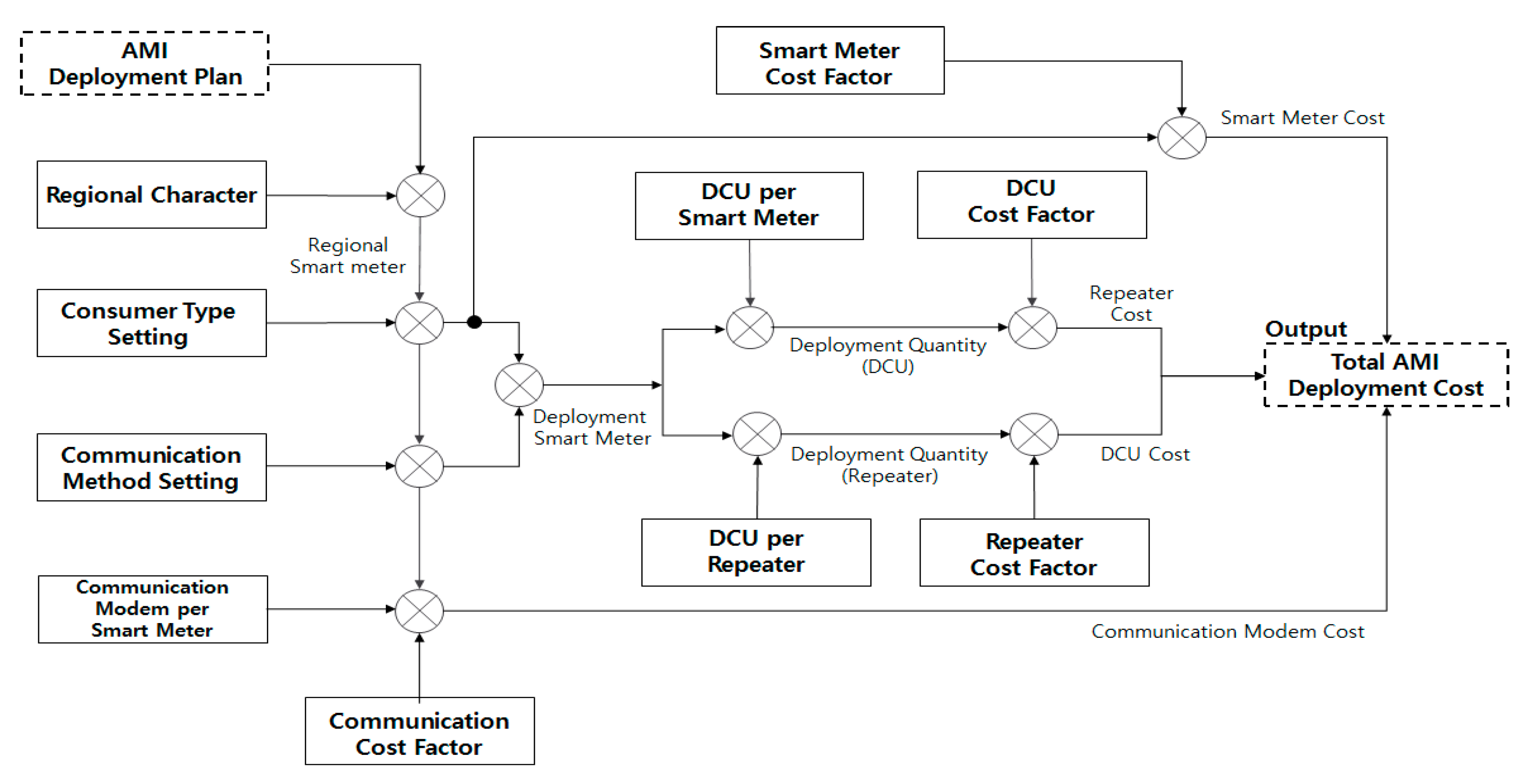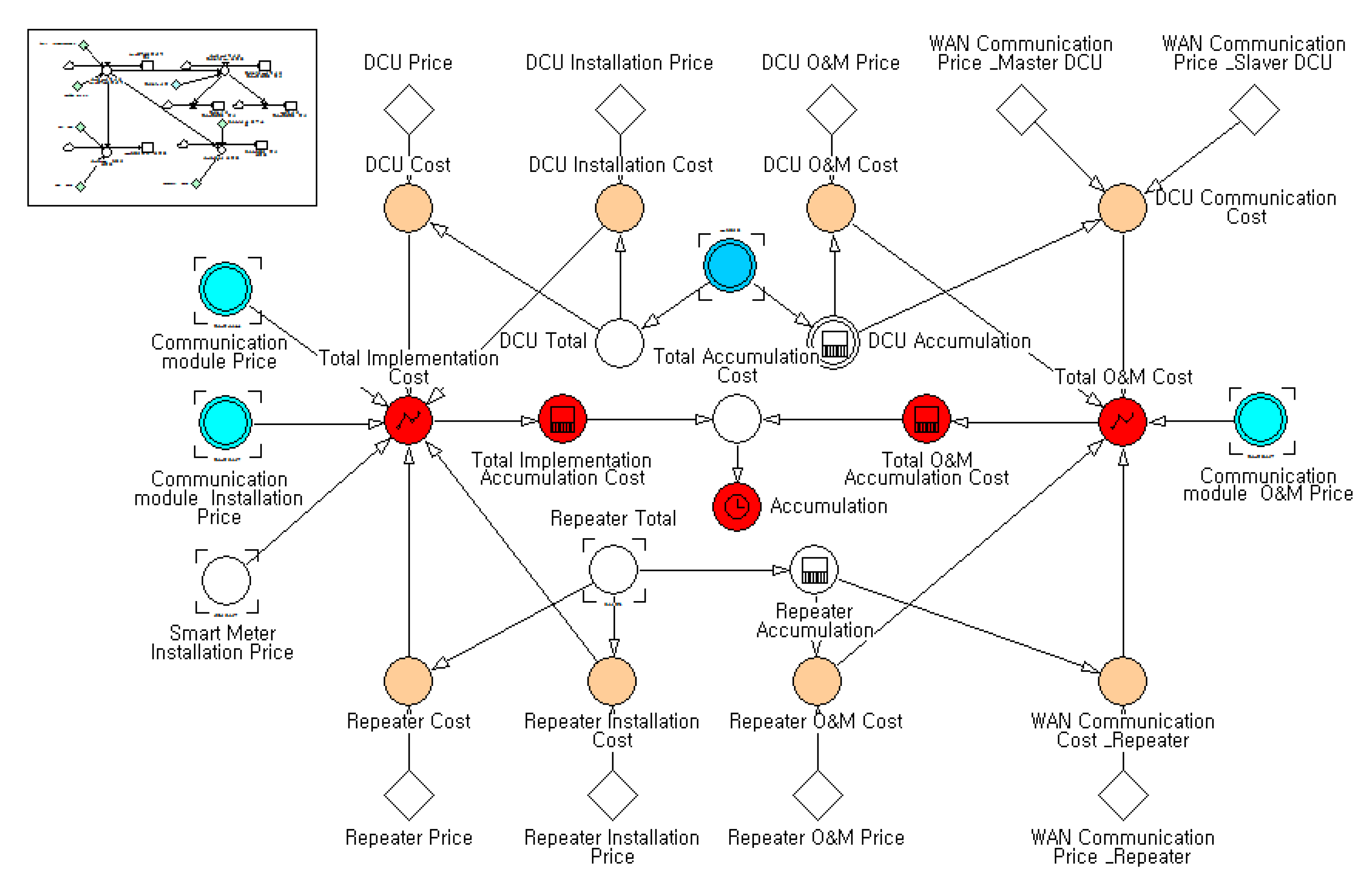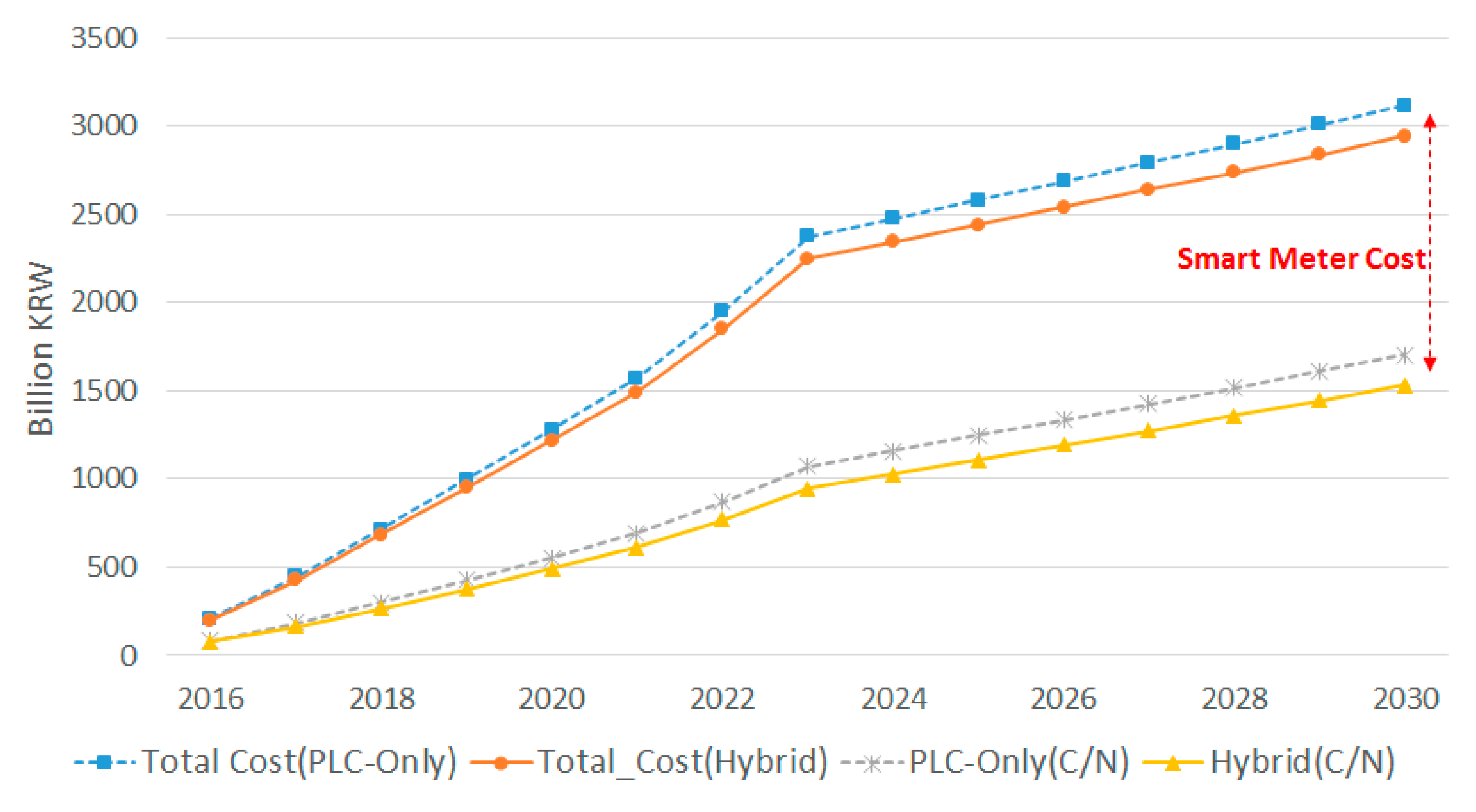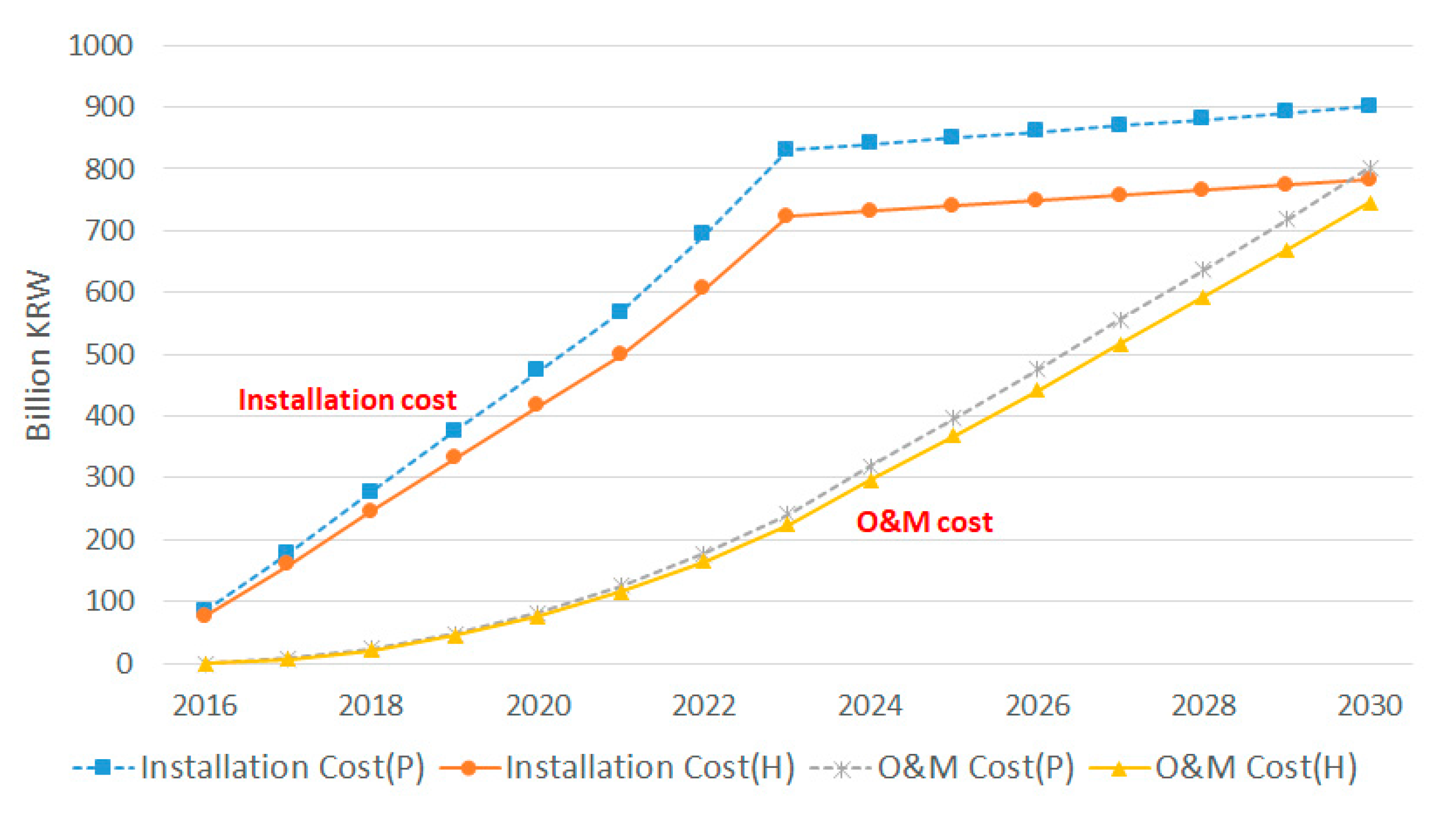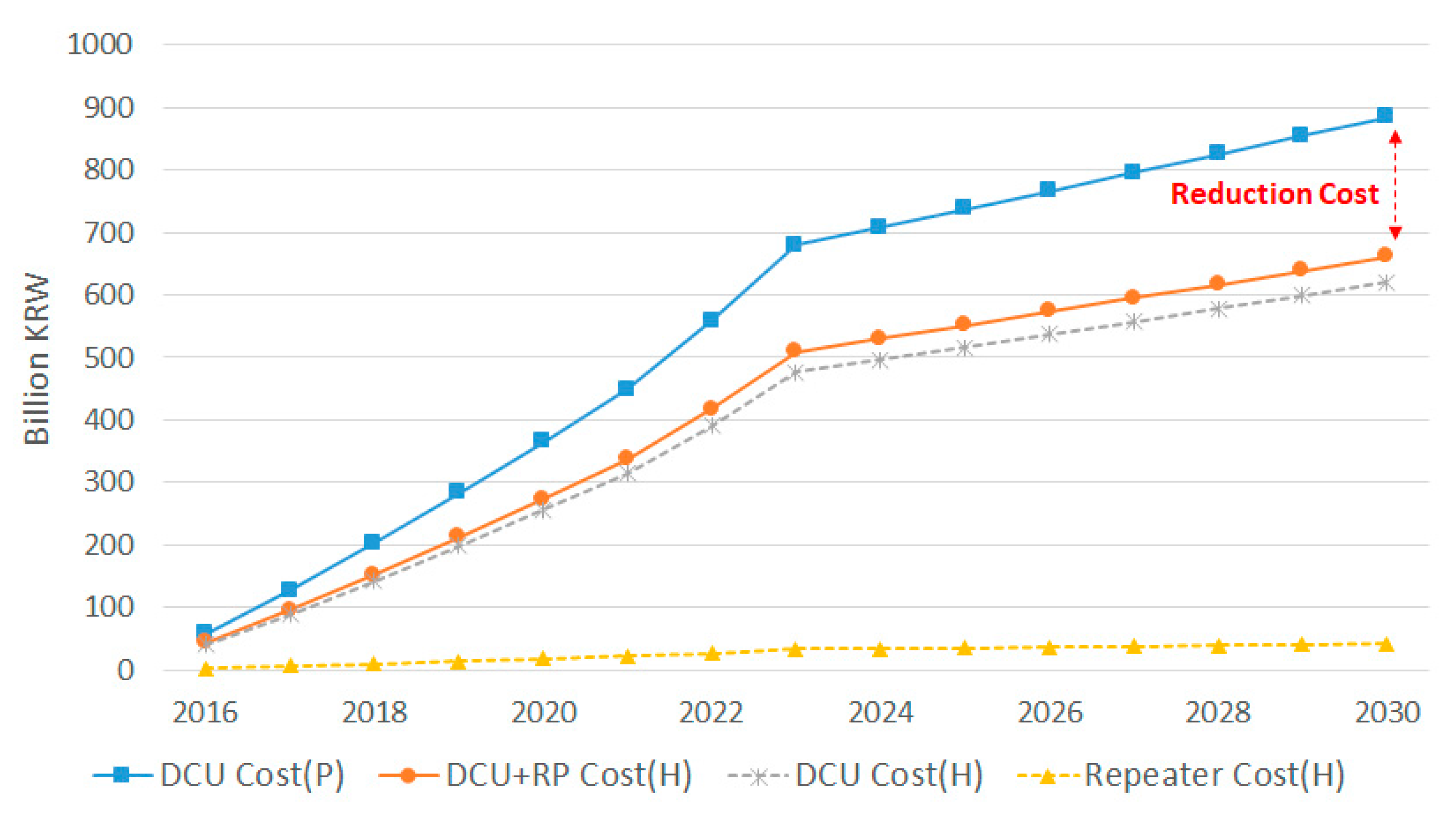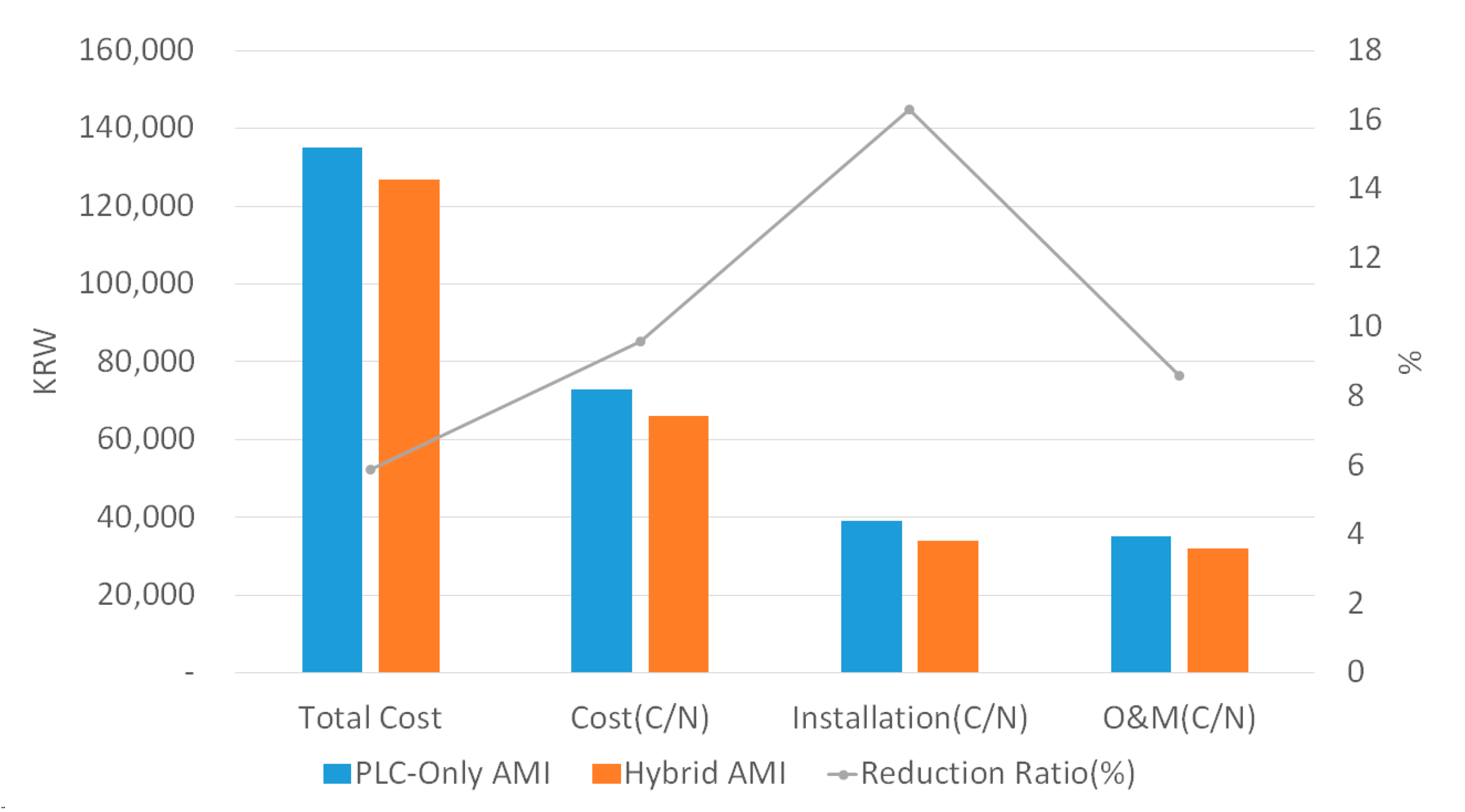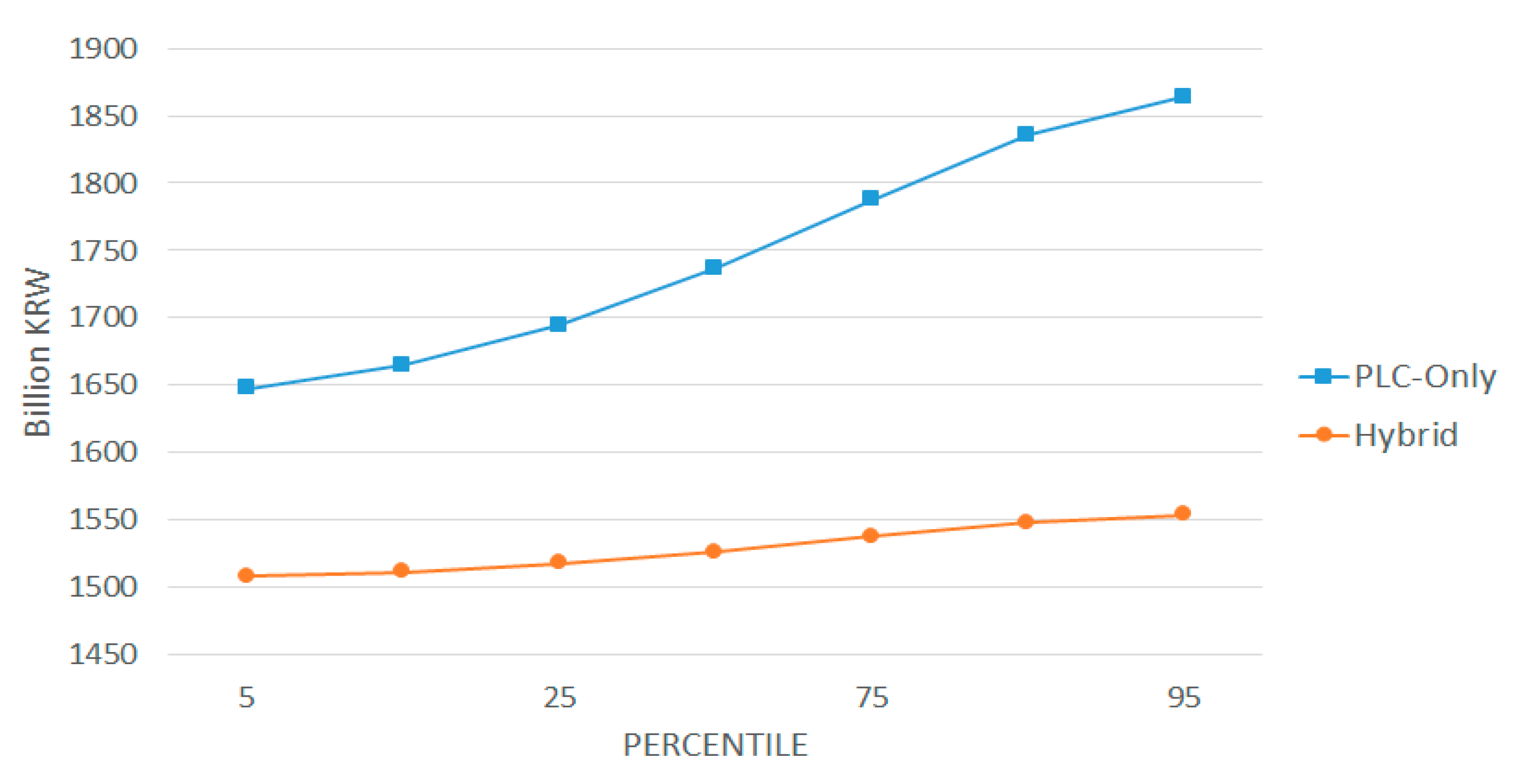1. Introduction
Advanced metering infrastructure (AMI) is the electricity service infrastructure between electricity consumers and suppliers that uses two-way communications to read energy use, collect energy-use information, apply rates, and enable additional services [
1,
2,
3,
4]. The technology is essential for the realization of a smart grid environment. Currently, the provision of AMI is spreading rapidly worldwide. In Europe, by the middle of 2012, about 90 smart-metering pilot projects and country-specific rollouts were conducted. According to the European Commission, Member States aimed to supply 200 million smart meters by 2020 [
5]. This indicates that more than 70% of users will be included in Smart Grid technology through the use of smart meters [
6]. The United States has installed 65 million smart meters covering more than 50% of households by the end of 2015 and expects to install 90 million smart meters by 2020 [
7]. As part of the national plan, China is promoting the spread of smart meters, and 150 million smart meters have been introduced by 2015 and are expected to grow steadily at an average annual rate of 8% by 2020 [
5,
8]. Japan has set a goal of monitoring 80% of its electricity consumption nationwide and is expected to install a smart meter in about 80 million households by 2024 [
5]. According to industry reports in India, it is estimated that by 2021, 130 million smart meters with both PLC and wireless technologies will be installed [
5]. In Korea, the utility company (KEPCO) is aiming for a 100% installation of smart meters in the country’s entire 21.94 million low-voltage customers by 2020 [
9,
10].
To implement AMI, various communications technologies are being used based on application environments according to the utility’s preference. AMI communication can be classified into the wire and wireless communication [
11]. One of the popularly used wire communication methods is power line communication (PLC) [
12], which has the advantages of low investment cost by using existing power line infrastructure [
12,
13,
14]. PLC is divided into broadband PLC, using frequencies up to 30 MHz, and narrowband PLC using frequencies up to 500 kHz [
5]. However, this has a disadvantage in that the bandwidth is limited and the attenuation increases as the transmission distance increases [
15,
16]. Wireless communication methods include WiFi-Mesh (IEEE 802.11s), ZigBee (IEEE 802.15.4), smart utility network (SUN: IEEE 802.15.4g), and TV White Space (IEEE 802.22b) [
12,
13,
17]. The wireless communication methods have the advantages of high data throughput, fast data rate and flexible network configuration [
12,
15]. However, there is a disadvantage that interference caused by other wireless devices, the terrain and objects can occur [
15]. This AMI communication technology is applied considering the regional characteristics and policies of each country [
18]. In Europe, PLC is used as a typical communication technology, and especially narrowband PLC is widely used [
19]. RF is preferred in the United States, and Pacific Gas & Electric in California and Florida Power and Light Company use RF Mesh [
5,
19]. Canada uses RF Mesh and ZigBee, China prefers PLC, and India uses PLC and wireless technology [
19].
Utility companies tend to select a single communication technology because of the resulting cost reduction and ease of maintenance. However, the choice of a single technology can lead to unexpected adverse effects in some areas. For example, when using a power line communication (PLC) technology, the installation cost can increase in farming and fishing areas due to the decrease of customer density between spans. On the other hand, the communications performance can be degraded in downtown underground distribution line sections. In the underground distribution line sections, signal leakage to the surrounding material around the conduit through the distribution line is high, resulting in a high level of signal attenuation [
20,
21]. Especially, there are some study results suggesting that the communication performance is significantly lower than that of the high-voltage line, which has excellent shielding characteristics in the case of low-voltage lines [
22,
23,
24,
25,
26,
27].
A hybrid AMI using multiple communication technologies depending on the situations is one of the solutions to solve the problems [
28]. Improving on the existing method, which limits communications between the smart meter and the data concentration unit (DCU) to one technology, a hybrid AMI is a system that is configured with either a mixed method using multiple communications technologies as supplements or a combined method using multiple communications technologies for dualization.
For successful implementation of a hybrid AMI, technical issues should be resolved and the hybrid AMI should be cost effective and economically feasible. Accordingly, a cost analysis that takes account of all the factors causing cost fluctuation must first be conducted during the initial stages of deploying the hybrid AMI.
According to analyses performed on the economics of existing AMI technologies, the communications network accounts for an average of 45% of the total installation cost [
29]. Since the equipment comprising the communications network entails operation and maintenance (O&M) costs, a communications network installation plan suited to the installation environment needs to be devised during the initial stages of the undertaking from a long-term perspective. Since the installation cost of a communications network is influenced by the density of the installation environment, a hybrid AMI, which allows the configuration of a flexible network using both wired and wireless communications, can be a good alternative, both technically and financially [
29].
This study conducted a cost analysis based on the density of the installation environment and the configuration of the communications network to evaluate the economic effects of installing a hybrid AMI communications network. To this end, the study deduced major cost factors of the hybrid AMI and built a cost model taking account of consumer density and wire methodology. Korea had determined to use a broadband PLC technology based on IEC 12139-1 at the initial stage of AMI deployment. Recently, adopting a hybrid AMI method has been studied to improve economics and efficiency combining wireless technology. Therefore, a PLC-only AMI method is considered as the reference model, and a hybrid AMI method with PLC and wireless communication are compared in this work. Here, ZigBee and SUN are implicitly considered as the wireless technology. In this study, the density of the installation environment was simplified into downtown and non-downtown areas, and it was assumed that hybrid AMI is deployed in the overhead distribution line in a non-downtown area, which is a low-density region. A simulation was run based on a power line communication (PLC)-only AMI method installation and a hybrid AMI method installation under the AMI deployment plan considering the situation of Korea and the proposed cost model. Based on the simulation results, a comparison was made of major cost factors and a sensitivity analysis was performed, after which the economic effects of the hybrid AMI were presented accordingly.
4. Conclusions
This study conducted a simulation based on the density of the installation environment and the configuration of the communications network to analyze the economic effects of installing a hybrid AMI communications network. It was assumed that a hybrid AMI was deployed in the overhead distribution line within a low-density region, and the results were compared and analyzed against the PLC-only method. Based on the total cost, including smart meters, the results of the cost analysis show that the hybrid AMI has a 5.6% or 174 billion KRW cost reduction effect compared to the PLC-only AMI. Based on the cost of the communications network, excluding smart meters, the results show that the hybrid AMI has a cost reduction of 173 billion KRW in comparison to the PLC-only AMI, which is equivalent to a 10.2% cost reduction effect. The total cost per consumer, including smart meters, for the hybrid AMI was 127,000 KRW, which is a 5.7% decrease compared to the PLC-only AMI. From the perspective of the communications network cost, the total cost per consumer, including smart meters, for the hybrid AMI was at 66,000 KRW, a 9.6% cost cut. The installation cost and O&M cost for the deployment of the hybrid AMI reduced by 13.1% and 7%, respectively, compared to the PLC-only AMI, and the reduced costs were significant. Examining the cost per piece of equipment from the perspective of the communications network cost, the analysis shows that the DCU cost had the highest reduction effect, dropping 25.3% following the deployment of the hybrid AMI. On the contrary, the cost of communications modems increased 6% due to the influence of the modem unit price. A sensitivity analysis of both deployment methods for communications network installation was performed, and the results indicated that the decline in the cost for the hybrid AMI in each section was as high as 19.1%, which was the maximum cost reduction effect. Based on these findings, it was evident that the hybrid AMI was economically effective in Korea. While this study applied the hybrid AMI in a non-downtown area, there would be more economic gain if the application were to expand into the downtown area. In addition, if a detailed system of area classification were used and quality of service for communications network configuration were applied, it would be possible to establish an effective configuration system for the communications network and to devise a deployment plan that takes account of reading cycles and regional characteristics. Although the cost analysis is performed for Korea AMI case in this work, the proposed approach is modeled with a system dynamics tool and can be easily applied to other cases by applying the specific scenarios and parameters. Future research will involve studying an optimal implementation plan for a hybrid AMI that configures an optimal communications network with minimum cost, taking account of the technical factors of building a communications network.

